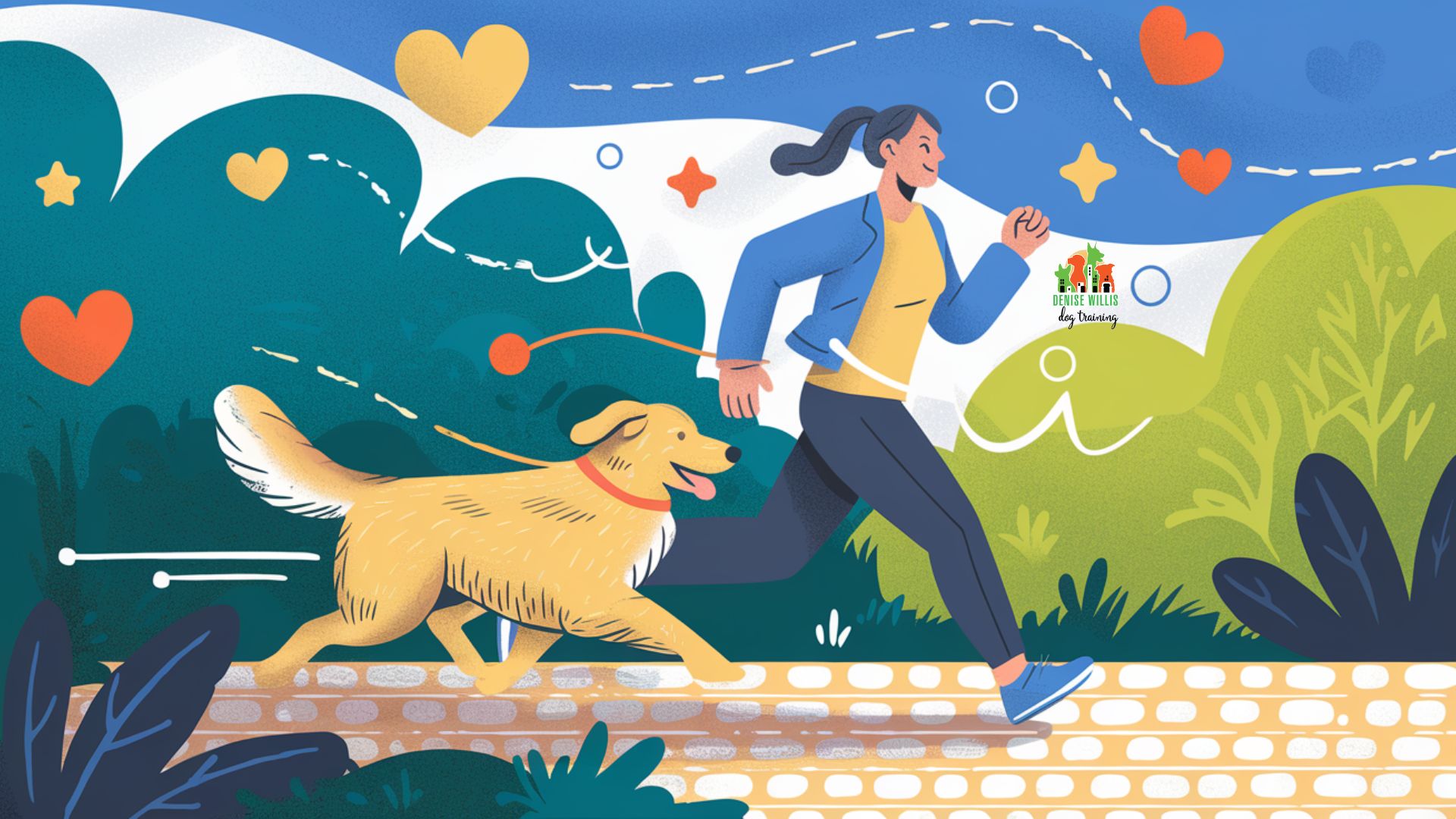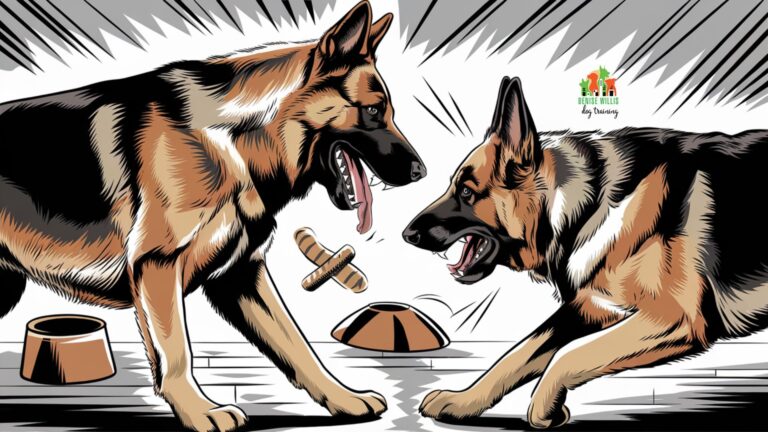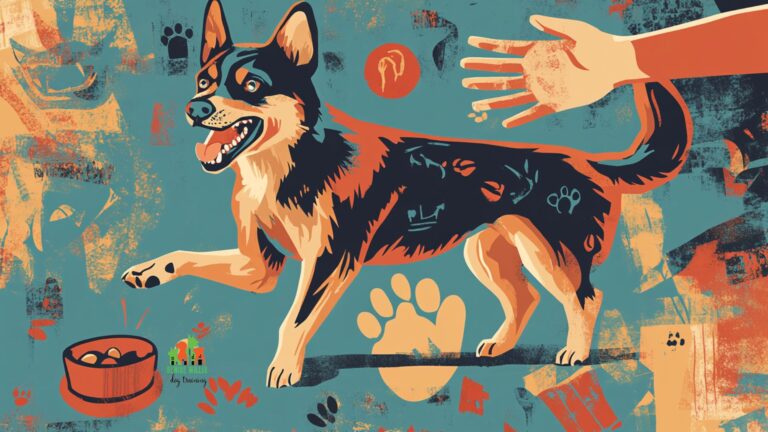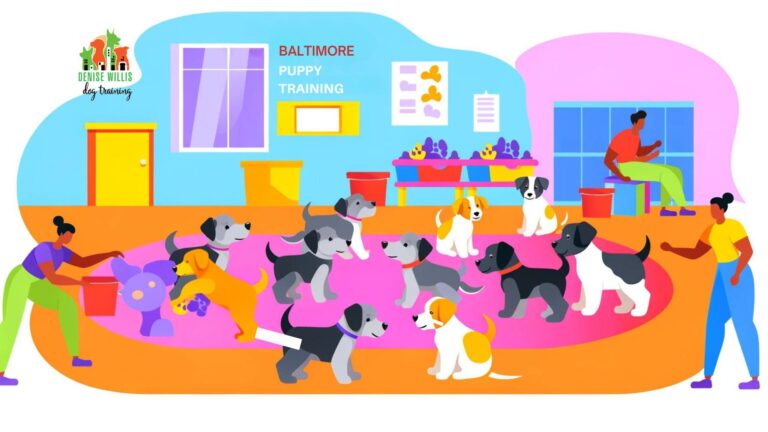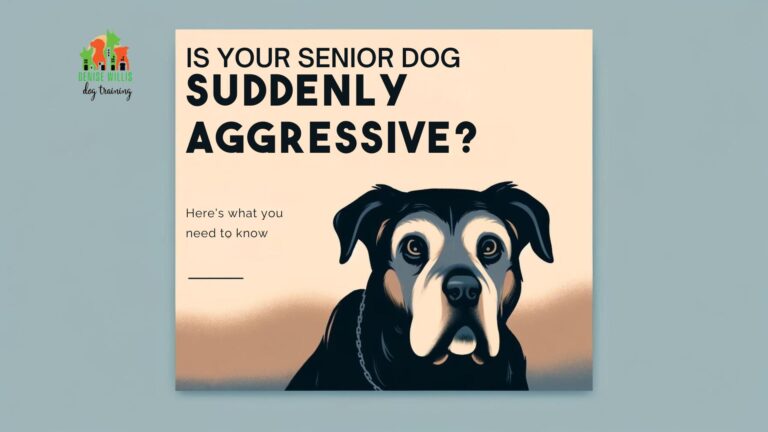From Aggression to Zen: How Exercise Transforms Dog Behavior
📍 Service Area Notice: DW Dog Training provides in-person training services exclusively in the Greater Baltimore area. While our blog content is designed to help dog owners internationally, our hands-on training services are locally focused. For readers outside our service area, we hope you find value in our articles and welcome you to reach out with questions!
What should you do when your usually sweet pup transforms into a canine version of the Incredible Hulk, minus the purple shorts. Before you resign yourself to a lifetime of apologetic smiles and “He’s usually so friendly!” explanations, there’s a science-backed solution that doesn’t involve expensive gadgets or questionable crystal healing (though if that’s your thing, no judgment).
Research consistently shows that regular physical activity serves as a powerful natural aggression reducer, transforming reactive dogs into calmer, more balanced companions through the strategic application of exercise. Think of it as your dog’s version of a stress-relieving yoga retreat – minus the expensive leggings and green smoothies.
But, here’s the kicker. It’s not just about throwing a ball until your arm falls off.
The secret lies in understanding the fascinating connection between physical activity and canine behavior.
Ready to turn your furry friend from Cujo to calm?
Key Takeaways
Before we unleash the full power of exercise on your dog’s behavioral challenges, let’s fetch some essential points that’ll guide our journey:
- Physical movement does more than just tire out your pup
- Strategic exercise creates lasting behavioral change
- Consistency matters more than intensity
- Mental stimulation amplifies physical benefits
- Individual approaches yield better results than cookie-cutter solutions
- Safety and progression are your best training partners
Understanding the Exercise-Behavior Connection
Let’s get nerdy for a minute (in a fun way, I promise). Before we start turning your living room into a doggy fitness center, you need to understand why exercise works its magic on aggressive behavior. Spoiler alert: it’s not just about wearing out your four-legged friend until they’re too tired to chase the mailman.
Brain Chemistry Basics
Remember that blissed-out feeling after a good workout?
Your dog experiences something similar, but with even more profound behavioral impacts. Physical activity triggers a cascade of beneficial neurochemical reactions that directly impact mood, stress levels, and aggressive tendencies, creating a natural pathway to calmer behavior.
When dogs exercise, their bodies become natural pharmacies, producing:
- Serotonin: Nature’s chill pill
- Dopamine: The “good boy” feeling amplifier
- Endorphins: Internal stress busters
- Oxytocin: The bonding hormone that makes you and your pup besties
This chemical cocktail doesn’t just happen by accident. It’s your dog’s built-in system for maintaining emotional balance. Think of it as their internal mood DJ, mixing up the perfect blend of feel-good vibes.
Physical and Mental Benefits
Beyond the brain chemistry party happening upstairs, exercise creates a ripple effect throughout your dog’s entire system. Regular physical activity establishes a foundation for balanced behavior by addressing both physical tension and mental stress, creating a comprehensive approach to aggression management.
Exercise acts like your dog’s reset button, helping them:
- Release pent-up physical tension
- Process environmental stressors
- Develop better impulse control
- Improve focus and concentration
- Build confidence through mastery
- Establish healthy sleep patterns
But here’s the really cool part. These benefits compound over time. Just like compound interest but with better treats.
The Numbers Don’t Lie (But They Do Wag Their Tails)
Think your dog’s transformation from reactive rover to peaceful pup sounds too good to be true?
Well, grab your calculator and prepare to be amazed because we’ve got the stats to prove that exercise isn’t just a fun way to tire out your four-legged friend, it’s practically mathematical magic for managing aggression.
| Finding | Percentage | Details | Source |
|---|---|---|---|
| Exercise Impact on Aggression | 50% | Reduction in aggressive behaviors after 60 minutes daily exercise over 12 weeks | [1] |
| Trainer Consensus | 89% | Professional trainers who rate regular exercise as “very important” for managing aggression | [3] |
| Off-leash Exercise Benefits | 20% | Reduction in aggressive behaviors towards unfamiliar dogs with regular off-leash exercise | [4] |
| Agility Training Impact | 35% | Decrease in fear-based aggression through agility training compared to control group | [2] |
| Socialization Effect | 70% | Reduced likelihood of developing fear-based aggression in well-socialized dogs | [3] |
Look at those numbers!
They’re more impressive than your dog’s ability to hear a cheese wrapper from three rooms away. That 50% reduction in aggressive behaviors? That’s like turning your dog’s “volume” from an 11 down to a manageable 5.5. And when 89% of professional trainers agree on something, it’s like getting almost all of your local dogs to sit at the same time. Pretty remarkable stuff.
What really wags our tail is that 70% reduced likelihood of developing fear-based aggression in well-socialized dogs. That’s better odds than most of us have at remembering where we put our car keys!
These aren’t just numbers on a page. They’re proof that every walk, play session, and game of fetch is building a better, more balanced buddy.
The Big Picture: Exercise’s Impact on Aggression
Want to see how all these numbers paint the bigger picture of your dog’s transformation? We’ve broken down the most jaw-dropping statistics into bite-sized pieces (pun absolutely intended). Think of this as your cheat sheet for explaining to skeptical neighbors why you’re out there playing fetch at 7 AM.
Exercise: Your Secret Weapon Against Dog Aggression
Brain Chemistry Benefits
Regular exercise triggers a natural pharmacy of feel-good hormones, reducing stress and aggressive tendencies by up to 50% in just 12 weeks.
Social Success
Well-exercised dogs show 70% less fear-based aggression and are 20% less likely to react negatively to unfamiliar dogs.
Professional Backing
89% of professional trainers rate regular exercise as crucial for managing aggressive behaviors and building balanced dogs.
Long-term Impact
Dogs getting 7+ hours of weekly exercise are 3x less likely to develop aggressive behaviors over time.
Pretty impressive, right?
These aren’t just fancy graphics and numbers. They’re the blueprint for your dog’s journey from reactive to relaxed.
And the best part?
You don’t need a PhD in canine psychology to make it happen. Just your walking shoes, some dedication, and maybe a few extra tennis balls.
Now that you’ve seen the big picture, let’s dive into creating an exercise program that’ll have your pup collecting degrees in good behavior.
Creating an Effective Exercise Program
Now that we understand the “why” behind exercise’s power over aggression, let’s tackle the “how.” Creating an effective exercise program is like being your dog’s personal trainer – minus the awkward locker room conversations and protein shake recommendations.
Activity Selection
Different dogs need different workout plans, with daily exercise requirements ranging from 30-120 minutes depending on breed, age, and temperament. Let’s break it down by energy levels:
High-Energy Breeds (Border Collies, Belgian Malinois, Huskies):
- 1-2 hours of intense daily activity
- Running or biking sessions
- Agility training
- Advanced obedience work
- Structured play sessions
- Swimming (when available)
- Fetch with progression
- Sports training
Medium-Energy Breeds (Labs, Golden Retrievers):
- 45-90 minutes of moderate activity
- Long walks with training
- Interactive games
- Basic agility work
- Nose work activities
- Structured playdates
- Swimming sessions
- Modified sports activities
Low-Energy Breeds (Bulldogs, Great Danes):
- 30-45 minutes of gentle activity
- Short, frequent walks
- Mental stimulation games
- Light play sessions
- Basic training exercises
- Social interaction focus
- Pool therapy
- Calm sporting activities
Exercise Timing
Just like you wouldn’t start your day with a marathon (unless you’re one of those mystifying morning people), timing your dog’s exercise can make or break its effectiveness. Think of it as scheduling their optimal zoom times for maximum behavior benefits.
Strategic timing of exercise sessions significantly amplifies their impact on aggressive behavior, creating lasting positive changes in your dog’s daily routine. Let’s break down the prime time slots:
Morning Glory:
- Takes advantage of natural energy peaks
- Sets a positive tone for the day
- Reduces anxiety-driven behaviors
- Creates a structured routine
- Prevents energy buildup
- Establishes healthy patterns
- Promotes better daytime behavior
- Maximizes training effectiveness
Evening Excellence:
- Helps process daily stress
- Promotes better sleep patterns
- Reduces nighttime restlessness
- Strengthens bonding time
- Prevents bedtime zoomies
- Calms evening anxiety
- Creates relaxation triggers
- Supports healthy rest cycles
Progressive Implementation
Think of building your dog’s exercise routine like training for a marathon – if marathons involved tail wagging and occasional squirrel distractions. Start slow, build steadily, and celebrate the small victories (treats optional but recommended).
Week 1-2:
- Establish baseline activity levels
- Introduce structured walking routines
- Begin basic training integration
- Monitor energy and response
Week 3-4:
- Increase duration gradually
- Add new activities slowly
- Incorporate more challenging elements
- Track behavioral changes
Week 5-6:
- Expand activity variety
- Introduce social components
- Enhance training complexity
- Document progress markers
Your Roadmap to Success
Ready to turn your reactive rover into a peaceful pup?
Here’s your week-by-week guide to making it happen. Think of it as your dog’s personal training schedule, minus the expensive gym membership and questionable protein shakes.
Your 12-Week Journey to a Calmer Canine
Weeks 1-2: The Foundation Phase
Time to get real about your pup’s behavior! Start with a vet check (because sometimes it’s not attitude, it’s arthritis), document their spicy moments, and begin daily 30-minute walks. Think of it as your dog’s version of couch-to-5K, minus the fancy running shoes.
Weeks 3-4: Level Up Time
Now we’re cooking! Extend those walks to 45-60 minutes and add twice-daily play sessions. Mix in some basic obedience training – because nothing says “I’m too tired to be cranky” like mastering a perfect sit-stay combo.
Weeks 5-6: The Spice-It-Up Stage
Variety is the spice of life! Introduce swimming (for the water lovers), agility (for the show-offs), and mental gymnastics with puzzle toys. It’s like CrossFit for dogs, but with more tail wagging and less Instagram posting.
Weeks 7-8: Social Butterfly Time
Start controlled doggy meet-and-greets (think speed dating, but with more sniffing), amp up the exercise intensity, and master the art of the post-workout chill. Because every good workout deserves a proper cool-down!
Weeks 9-10: The Consistency Champion
Keep that routine rolling like a well-oiled machine. Track those behavior changes – you might notice your formerly grumpy pup is now more zen master than warrior prince!
Weeks 11-12: The Victory Lap
Time to celebrate those wins! Assess the improvements, fine-tune any remaining rough spots, and set those long-term goals. Your dog has just graduated from Aggression Management University – treats for everyone!
Remember, this timeline is a guide, not a strict rulebook.
Some dogs might zoom through these stages faster than a squirrel on espresso, while others might need a bit more time to master each level. The key is consistency and patience. Rome wasn’t built in a day, and your dog won’t become a zen master overnight. But with dedication and this structured approach, you’ll be amazed at the transformation!
Beyond Physical Activity
Exercise alone is like serving spaghetti without sauce – it works, but you’re missing out on the good stuff. A comprehensive approach combining physical activity with mental challenges creates the most effective strategy for managing aggressive tendencies.
Mental Stimulation Components
Remember that time you were physically exhausted but your brain wouldn’t shut up about that embarrassing thing you did in third grade? Dogs experience something similar – physical tiredness doesn’t always equal mental calm.
Brain Games Supreme:
- Nose work challenges
- Puzzle feeders
- Training sessions
- Scent tracking
- Object discrimination
- Pattern recognition
- Memory exercises
- Problem-solving tasks
Smart Play Solutions:
- Hide and seek adventures (like Marco Polo, but with more sniffing)
- Shell games (the casino version is less fun, trust me)
- Target training (teaching your dog to boop things with their nose)
- Sequential learning (because even dogs need to level up)
- Environmental enrichment (making your backyard a doggy Discovery Zone)
Social Aspects
Remember high school gym class?
Some loved it, some dreaded it, but everyone learned something about social interaction – even if it was just how to dodge a dodgeball. Dogs need similar structured social experiences to develop healthy behaviors.
Controlled social interaction during exercise provides crucial opportunities for dogs to learn appropriate behaviors and reduce fear-based aggression. Think of it as doggy finishing school, minus the fancy manners and tea parties.
Structured Social Settings:
- Parallel walking with calm dogs (like a canine buddy system)
- Supervised play sessions (think recess with referees)
- Distance-based introductions (social distancing, dog edition)
- Group training classes (where everybody knows your bark)
- Sports team activities (synchronized swimming optional)
Common Challenges and Solutions
Even Olympic athletes face training hurdles, and your dog’s journey to zen master status is no different. Let’s tackle these challenges head-on, because giving up is so 2023.
Weather Warriors
Mother Nature doesn’t always cooperate with your exercise plans. When the weather outside is frightful, your exercise game needs to stay delightful.
Indoor Alternatives:
- Stair workouts (vertical zoomies)
- Hallway sprints (carpet drifting included)
- Living room agility (goodbye, coffee table)
- Treadmill training (start slow, end proud)
- Indoor fetch (RIP favorite lamp)
Space Invaders
Not everyone has a football field for a backyard. For city dwellers and apartment warriors, space comes at a premium. Here’s how to make the most of your square footage:
Creative Space Solutions:
- Vertical space utilization (up is the new out)
- Compact exercise equipment (think tiny but mighty)
- Time-efficient workouts (quality over quantity)
- Multi-purpose activities (work smarter, not harder)
- Small space games (big fun in tiny places)
Implementation Guide
Success loves good planning almost as much as your dog loves that one squeaky toy. Let’s break down how to make this exercise revolution happen.
Weekly Warriors Schedule
Monday Motivation:
- Morning: Cardio blast (chase the morning blues away)
- Afternoon: Skills practice (because smart is the new tired)
- Evening: Cool-down walk (sunset struts)
Training Tuesday:
- Morning: Strength work (puppy pushups anyone?)
- Afternoon: Brain games (making Einstein jealous)
- Evening: Social skills (friendly neighborhood pup patrol)
Wonderful Wednesday:
- Morning: Recovery activities (gentle like Sunday morning)
- Afternoon: New skills (teaching old dogs new tricks)
- Evening: Adventure walk (exploring the urban jungle)
Thrilling Thursday:
- Morning: High-intensity fun (channeling their inner athlete)
- Afternoon: Puzzle time (because Einstein wasn’t built in a day)
- Evening: Chill skills (zen master in training)
Fitness Friday:
- Morning: Endurance building (marathon dog in the making)
- Afternoon: Agility games (ninja warrior, furry edition)
- Evening: Social hour (Friday night lights, doggy style)
Weekend Warriors:
- Longer duration adventures (time to explore)
- New environment exposure (world tour, leash required)
- Family fun integration (making memories, one tail wag at a time)
Remember, this schedule isn’t carved in stone like your neighbor’s “Keep Off The Grass” sign. Adjust it based on your dog’s energy levels, because some days they’re more couch potato than canine athlete.
Progress Tracking
Monitoring your dog’s progress isn’t just about counting steps – it’s about tracking transformations in behavior, energy levels, and overall happiness. Think of it as your dog’s personal growth journey, minus the inspirational Instagram quotes.
Daily Tracking Points:
- Energy levels (from sloth to squirrel)
- Behavioral responses (what triggers the inner Hulk)
- Exercise completion (did we crush it or just crush the couch?)
- Recovery patterns (bounce back or nap attack)
- Social interactions (friend goals or lone wolf?)
- Aggression triggers (what makes them spicy)
- Response improvements (progress not perfection)
Monthly Milestones:
- Decreased reactive episodes
- Improved focus during chaos
- Better response to commands
- Calmer default state
- Stronger social skills
- Enhanced recovery time
- Reduced anxiety signals
Safety First, Zoomies Second
Before you transform your pup into the next canine CrossFit champion, let’s talk about keeping them safe while they get their swole on.
Watch Those Warning Signs
Exercise should energize and calm your dog, not exhaust them to the point of concerning behavioral changes. Here’s what to watch for:
Physical Red Flags:
- Excessive panting (beyond the normal tongue-out happiness)
- Drooling changes (more than usual cookie anticipation)
- Gait alterations (the funny walk isn’t always funny)
- Muscle tremors (shake it off, but not like that)
- Delayed recovery (when “give me a minute” becomes twenty)
Behavioral Warning Signs:
- Increased irritability (from Dr. Jekyll to Mr. Hide)
- Decreased enthusiasm (when fetch becomes “fetch yourself”)
- Changed interaction style (suddenly too cool for school)
- Unusual resistance (couch potato revolution)
- Stress signals (the canine equivalent of “I can’t even”)
Product Recommendations
Think your pup needs a home gym membership? Before you start installing tiny treadmills and pawsonal training equipment, check out our tested and approved gear for turning your energetic friend into a balanced buddy. No protein shakes required!
- Chuckit! Sport Ball Launcher: Transform your average game of fetch into an Olympic-worthy event. This simple but mighty tool will have your arm thanking you while your dog thinks you’ve suddenly developed superhuman throwing abilities. Warning: May cause your dog to look disappointedly at your regular throwing skills when not using the launcher. Perfect for those days when your pup has more energy than a toddler who found the cookie jar.
- Zippy Paws Burrow Interactive Dog Toy: Like Netflix for dogs, but with more squirrels and less subscription fees. This puzzle toy lets your pup channel their energy into something more productive than redecorating your furniture. Warning: May result in your dog becoming suspiciously good at problem-solving. Don’t be surprised if they start figuring out how to open the treat cabinet.
- Automatic Dog Ball Launcher: For when your arm needs a break but your dog still has the energy of a caffeinated squirrel. This automatic ball launcher keeps your pup moving while you catch your breath. Warning: Your dog may start expecting all household appliances to throw balls. The refrigerator will never meet their new expectations.
- iFetch Interactive Ball Launcher for Dogs: The ultimate in “set it and forget it” exercise equipment. Teaches your dog to load the balls themselves, making them both the athlete and the coach. Warning: Some dogs become so obsessed with this toy they start trying to teach their cat siblings how to use it too.
- Nina Ottosson by Outward Hound Dog Brick: Because sometimes mental exercise is just as tiring as physical exercise. This puzzle toy keeps your Einstein-in-fur-pants mentally stimulated and physically engaged. Warning: May turn your dog into such a problem-solving expert that they start helping your kids with their homework.
Further Reading
Ready to dive deeper into the world of exercise-based behavior modification? These articles are like your dog’s favorite tennis ball – you’ll keep coming back for more!
- Dog Aggression Solutions: A Complete Guide to Stopping Aggressive Behavior in Dogs: The ultimate playbook for understanding why your sweet pup sometimes acts like they’re auditioning for a role in “The Dog Who Growled Too Much.” Packed with practical solutions that go beyond just saying “no” and hoping for the best.
- 5 Proven Strategies to Stop Your Dog’s Aggression Towards Other Dogs: Transform your canine confrontationalist into a four-legged diplomat with these field-tested techniques. Because every dog deserves to be the popular pup at the park.
- How to Manage Your Dog’s Territorial Aggression: For when your dog thinks they’re the self-appointed mayor of your entire neighborhood. Learn how to help them understand that not everything that moves is a threat to their domain.
- 10 Warning Signs Your Dog Might Bite and How to Prevent It: Because dogs give us plenty of hints before things get spicy – we just need to learn their language. Spoiler alert: It’s not about mind reading, but it might make you feel like a dog whisperer.
- Decoding Your Dog: 15 Body Language Signals You Need to Know: Ever wish your dog came with subtitles? This is the next best thing! Learn to read your dog’s subtle (and not-so-subtle) body language cues before they need to resort to their outdoor voice.
Now that you’re armed with enough reading material to earn an honorary degree in Canine Exercise Science (sadly, not accredited… yet), it’s time to put that knowledge to work!
Remember, every dog’s journey from energetic escapader to a balanced buddy is unique. Kind of like how some of us excel at yoga while others still can’t touch our toes.
These articles are your roadmap to success, but don’t feel like you need to become a professor of puppy psychology overnight. Start with what resonates most with your situation, and remember: your dog doesn’t care if you’re not perfect, they just care that you’re trying.
Frequently Asked Questions About Exercises Impact on Dog Aggression
Because sometimes you need answers faster than your dog can destroy a new toy.
Q: How quickly will I see results from exercise?
A: Like that diet you started in January, results vary. Some dogs show improvement within weeks, while others take 2-3 months of consistent exercise to reveal their inner zen master. The key is consistency and proper intensity levels matched to your dog’s individual needs.
Q: Can exercise eliminate all aggressive behavior?
A: Exercise is powerful, but it’s not a magic wand (sorry, Harry Potter fans). Think of it as one awesome tool in your behavior modification toolbox, working best alongside training and sometimes professional guidance.
Q: What if my dog shows aggression during exercise?
A: Start in controlled environments where your dog feels like the king or queen they think they are. Gradually progress to more challenging situations, and don’t be shy about calling in the pros for backup.
Q: How do I know if I’m exercising my dog enough?
A: Watch their behavior, energy levels, and sleep patterns. If they’re still redecorating your furniture or writing their manifesto on the walls, they might need more action in their life.
Test Your Knowledge: Exercise vs. Aggression
Final Thoughts: From Chaos to Calm
Transforming aggressive behavior through exercise isn't just about wearing out your dog until they can't remember what they were mad about. It's about creating a lifestyle that promotes physical and mental well-being, builds confidence, and strengthens your bond.
While exercise is a powerful tool, sometimes even the most dedicated pet parents need a helping hand. That's where DW Dog Training steps in with our expertise in transforming challenging behaviors. Since 2001, we've been turning canine chaos into calm, using a unique blend of exercise-based training and behavioral modification techniques that go beyond basic commands.
Think of DW Dog Training as your dog's personal life coach minus the motivational posters and juice cleanses. Our certified trainers understand that every dog has their own "workout playlist" when it comes to managing aggression. Whether your pup needs help with basic manners or has a PhD in making the mailman regret their career choice, our personalized approach ensures your dog gets exactly what they need to succeed.
Remember:
- Every dog's journey is unique
- Consistency beats intensity
- Progress isn't always linear
- Patience is your secret weapon
- Celebrate small victories
Your pup's path from aggression to zen might have a few detours, but with proper exercise as your compass and us as your guide when needed, you're well on your way to a happier, more balanced companion. Plus, you might even get in better shape yourself – consider it a bonus for being an awesome dog parent.
We Value Your Feedback
Your experiences matter!
Share your journey, ask questions, or provide suggestions about using exercise to manage dog aggression. Your insights help us continue improving our training approaches and supporting other dog owners on similar paths.
Remember, every success story started with someone brave enough to take that first step or in this case, that first walk. Your dog's transformation journey begins now, one tail wag at a time.

